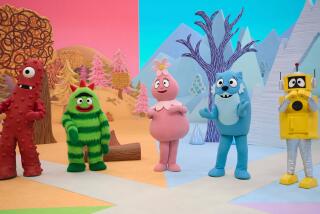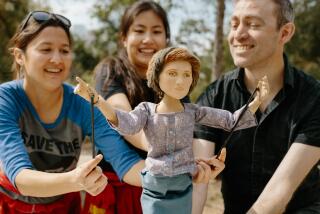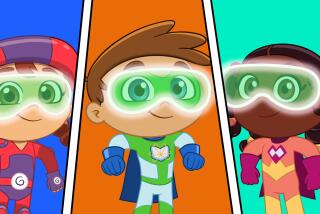SHOWS FOR YOUNGSTERS AND THEIR PARENTS TOO : It’s a small world too at the fuzzy and diverse ‘Puzzle Place’ on PBS
Don’t dismiss the variety of puppets on PBS’ new The Puzzle Place as mere clones of “Sesame Street” or “Allegra’s Window” characters.
These new fabric friends try to teach preschoolers diversity, through skin color and culture, with three boy and three girl puppets: Kiki is Latina; Leon, African American; Skye, Native American; Ben, Caucasian; Jody, Jewish; and Julie, Chinese American.
Solving problems in “The Puzzle Place” is done as the group works together to answer questions that confront today’s preschoolers, including peer pressure (randomly picking out “enemies” and calling eyeglass-wearing Ben “four eyes”), sexist attitudes (“girls don’t play with trains”), lifestyles (sticking to a bedtime), cultural prejudices (Kiki’s classmates make fun of her accent and not “looking” like the characters in their book), cultural differences (the kids share their native dances; Nia Peeples guests on this one), and the importance of team work (they put a band together, sounding awful individually but great together).
“The Puzzle Place” is produced by Los Angeles public broadcasting affiliate KCET and Lancit Media, makers of the popular and critically acclaimed “Reading Rainbow.” “Puzzle” won a PBS in-house contest, in which the Corporation for Public Broadcasting offered $4.5-million to help fund a new preschool series that “would deal with cultural understanding and problem-solving,” says Stephen Kulczycki, the show’s executive producer, who is also station manager and senior vice president of programming at KCET.
Kulczycki says that KCET “is extremely excited about this series, which offers a chance to break some molds in TV.”
The basic premise of “Puzzle Place,” he says, is to help kids get along and to help them make decisions based on self-esteem and respect of others.
“We want to show kids how to get along, in the way ‘Sesame Street’ did with counting, letters and shapes,” he says.
The show offers a format that mixes drama with animation. “We have all sorts of wonderful storytelling devices to create an atmosphere that’s extremely fun to watch, while offering positive models to help kids figure things out.”
Plus, each episode includes an original theme song sung by kids.
How did KCET-Lancit Media’s “Puzzle Place” win over some very tough PBS competition?
Don Marbury, director of the Television Program Fund for PBS, says, “They came in talking television to us. They knew what direction they wanted to move and give us a sense of the sights and sounds and textures and characters that would be involved in bringing ideas to the screen and our littlest Americans.”
Adds Kulczycki: “We’re also working on providing outreach and educational materials. But I think the idea, the basic idea, is an appealing one: to create an imaginary place where kids from different geographic and ethnic areas work on the puzzles of life.”
“The Puzzle Place” airs weekdays at 9:30 a.m. and noon and Saturdays and Sundays at 8:30 a.m. on KCET; Mondays through Saturdays at 8:30 a.m. on KPBS. For ages 2 to 6.
More Family Shows
Colorful puppetry fuels The Adventures of Timmy the Tooth (weekdays at 1:30 p.m. KTTV through Jan. 30, when it goes to home video only), a new syndicated show for preschoolers. Offering a message in every episode, the show combines education with musical entertainment. Monday’s premiere, “Operation Secret Birthday Surprise,” is fashioned as an “It’s a Wonderful Life” of sorts. Here, Timmy finds out what Flossmore Valley would be like without him. Original songs are also featured. For ages 2 to 6.
More to Read
The complete guide to home viewing
Get Screen Gab for everything about the TV shows and streaming movies everyone’s talking about.
You may occasionally receive promotional content from the Los Angeles Times.






